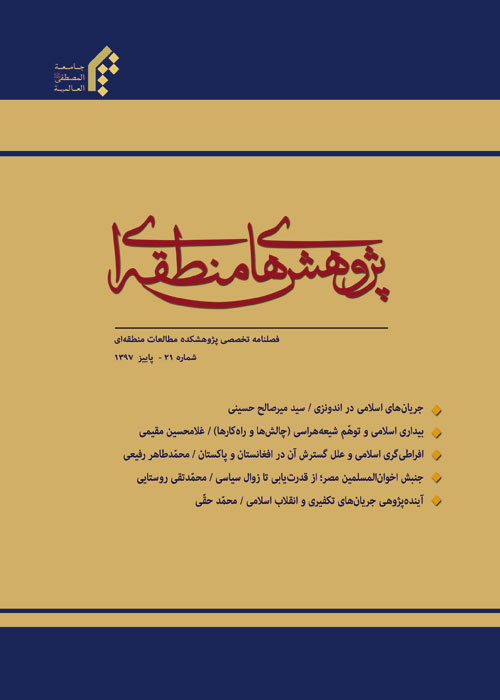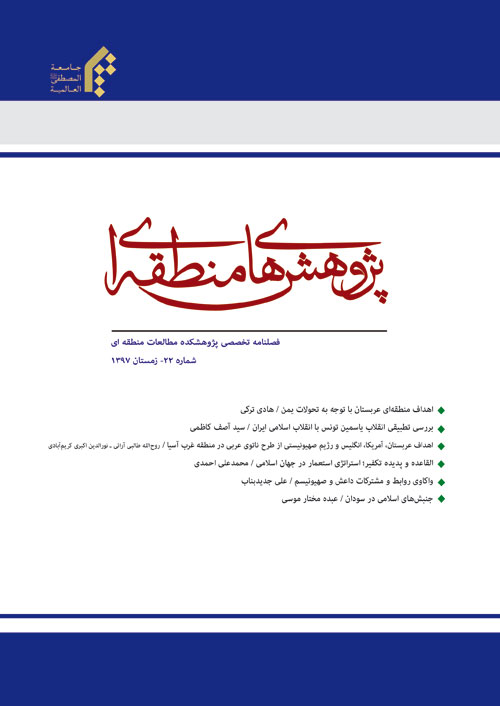فهرست مطالب

فصلنامه پژوهش های منطقه ای
سال ششم شماره 21 (پاییز 1397)
- بهای روی جلد: 100,000ريال
- تاریخ انتشار: 1398/01/10
- تعداد عناوین: 5
-
صفحات 7-29جریانهای دینی اسلامی اندونزی در تعامل با جریانهای فکری مرکز جهان اسلام از تنوع و تکثر بالایی برخوردار است. گروههای مسلمان به قطببندیهای دینی معرفتی دچار شده، در یک نظام کثرتگرای دینی فرهنگی زندگی میکنند. در این نوشتار به این پرسش میپردازیم که جریانهای دینی اندونزی کداماند و تاثیرپذیری آنان را از جریانهای دینی اسلامی خاورمیانه، بهطورمختصر با رویکرد جامعهشناسی تاریخی و روش تحلیلی- توصیفی بیان خواهیم کرد. مهم ترین جریان های اسلامی اندونزی، عبارتند از: تجدخواهی اسلامی، اصلاح طلبی اسلامی، سنت گرایی دینی، بنیادگرایی دینی، روشنفکری سکولار، روشنفکری لیبرال و جریان شیعی که همگی به نوعی متاثر از جریان های اسلامی در مرکز جهان اسلام و منطقه غرب آسیا بوده و در تعامل با آن شکل گرفته است.کلیدواژگان: جریان های اسلامی، اندونزی، تعاملات فکری، کثرت گرایی دینی
-
صفحات 31-60به همان نسبت که بیداری اسلامی- تمدنی، نویدبخش بازگشت به ارزش های عدالتخواهانه و کنش ارتباطی فرهنگی و مسالمت آمیز تمدن اسلامی است، به همان اندازه چالش ها و هراس هایی را نیز برای نظام سلطه ایجاد کرده است. بدین لحاظ طی سال های گذشته، بیداری تمدن اسلامی در درون خود، دو پتانسیل فرصت و تهدید را جای داده است. این تحقیق می کوشد توهم شیعه هراسی را به عنوان یکی از مهم ترین تهدیدات بیداری اسلامی- تمدنی کالبدشکافی کند. از این منظر، علل بروز و راهکارهای مقابله با آن مهم ترین دغدغه این نوشتار است. به نظر نگارنده، استراتژیست های هژمونی بین المللی بعد از ظهور بیداری تمدنی در ایران و صدور آن، متوجه پتانسیل بالای قدرت نرم شیعه در جهت جریان سازی عدالت طلبی، ظلم ستیزی و استقلال طلبی شدند که اگر کنترل نشود، بهزودی مرز های ایران را در می نوردد و زمینه گسترش اسلام سیاسی و دولت های اسلامی مشابه ایران را در منطقه خاورمیانه فراهم می آورد؛ ازاینرو پروژه شیعه هراسی به منظور مصادره مفاهیم اصیل اسلام ناب طراحی شده است که راهکار مقابله با آن، بصیرت سیاسی و واکاوی آموزه های صلح جویانه، وحدتطلبانه و کنش ارتباطی خردمندانه و معنویت خواهانه اسلام است.کلیدواژگان: بیداری اسلامی - تمدنی، شیعه هراسی، قدرت نرم اسلام، راهکارها
-
صفحات 61-88جهان اسلام بهخصوص افغانستان و پاکستان در چند دهه اخیر شاهد شکل گیری و رشد جریان های گوناگون با افکار متفاوت بوده است که بیشتر آنها با عناوینی همانند «افراطی گری مذهبی»، «اسلام گرایی»، «رادیکالیسم» و چه بسا «تروریسم» شهرت یافته اند. از اهداف و انگیزه های برخی اشخاص، مراکز و نهادهای مذهبی و همین طور سیاست های پلید استعمار و استکبار می توان به عنوان مهم ترین عوامل تاثیرگذار در این زمینه نام برد. در این میان چه بسا میان اصطلاح «افراطی گری» با عناوین مشابه آن، خواسته یا ناخواسته خلط می گردد؛ درحالیکه بسیاری از جریان های مذهبی خواسته های حق طلبانه و مطابق با موازین شرعی دارند و خطمشی آنان از کسانی که به خشونت های نامتعارف مذهبی و قومی دامن می زنند، جداست؛ بنابراین در نوشتار حاضر، ضمن بررسی ماهیت افراطی گری و شاخصه های اصلی آن، بهویژه در افغانستان و پاکستان، نقش دو عامل دخالت های خارجی و شیوه آموزش حاکم بر مدارس مذهبی، به عنوان بسترها و محرک های اصلی در این زمینه، مورد توجه قرار گرفته است.کلیدواژگان: افراطی گری، تروریسم، رادیکالیسم، افغانستان، پاکستان
-
صفحات 89-112اخوان المسلمین به عنوان یک جنبش سیاسی و اجتماعی، در تاریخ صدساله اخیر مصر تحولات زیادی را تجربه کرده است. به موازات این تحولات، کاوش در مورد رویکردها و سیاست های این جنبش بهویژه در دهه اخیر و پس از انقلاب 2011 مصر مورد توجه پژوهشگران قرار گرفته است. یکی از مسائل مهمی که توجه بسیاری از تحلیل گران را به خود جلب کرده است، قدرت یابی و زوال سریع این جنبش در عرصه سیاسی مصر می باشد؛ لذا این سوال ایجاد می شود که دلایل ظهور اخوانالمسلمین در راس قدرت سیاسی مصر چیست و چرا بهسرعت رو به زوال نهاد؟ این پژوهش در نظر دارد با استفاده از روش توصیفی تحلیلی به این پرسش پاسخ دهد. بررسی های پژوهش نشان می دهد عواملی مانند ایدئولوژی مذهبی، سازمان دهی قوی، برخورداری از حمایت های مردمی و تاکید بر مشارکت سیاسی، در قدرت گیری اخوان المسلمین نقش داشتند و در مقابل، مولفه هایی مانند فقدان رهبری قوی و منسجم پس از کسب قدرت، تناقض در عقیده و عمل، عدم اجماع و تعامل با دیگرگروه های سیاسی و وابستگی به غرب منجر به سقوط اخوان از اریکه قدرت شدند.کلیدواژگان: مصر، بیداری اسلامی، اخوان المسلمین، قدرت سیاسی، زوال قدرت
-
صفحات 113-139شکلگیری و گسترش جریانهای تکفیری با توجه به داشتن ویژگیهایی نظیر نقلگرایی، عقلستیزی، وحدتگریزی و خشونتگرایی چالشهای زیادی علیه گفتمان انقلاب اسلامی به وجود آورده است. بر این اساس جهت مقابله با خطرات این جریانها باید آیندهنگری و آیندهپژوهی مورد توجه و اهتمام قرار گیرد و سناریوهای مختلف طراحی گردد (بحث ضرورت). مقاله حاضر به دنبال پاسخگویی به این پرسش است که آینده جریانهای تکفیری در مواجهه با انقلاب اسلامی چگونه خواهد بود (سوال اصلی). با توجه به مولفههای اساسی سناریوپردازی و سناریونویسی سهگانه خوشبینانه، بدبینانه و استمرار وضع موجود، سناریوهای آینده فعالیت جریانهای تکفیری در مواجهه با انقلاب اسلامی شامل سناریوی قدرتیابی مجدد جریانهای تکفیری، سناریوی شکست کامل جریانهای تکفیری و سناریوی حفظ حاشیهای جریانهای تکفیری و بهرهبرداری قدرت های منطقه ای و فرامنطقه ای از آنها میشود (یافته پژوهش). در این مقاله جهت تبیین بحث از آیندهپژوهی و سناریوپردازی با روش سناریونویسی سهگانه استفاده شده است (مبانی نظری و روش).کلیدواژگان: جریانهای تکفیری، انقلاب اسلامی، آینده، سناریوپردازی
-
Pages 7-29The Islamic religious movements of Indonesia's Muslims are diversified in their interaction with the Middle East's intellectual currents. Muslim groups have experienced epistemological religious polarization and live in a culturally religious pluralist system. The country has the largest Muslim population among Islamic countries and is considered one of the largest archipelago of East Asia. Most Muslims in the country have Shafi'i religion in jurisprudence, and in theology are Matoridye. They turned to the formation of a new political system to emancipate colonial oppression. This Muslim country came to independence in 1945, and the revolutionary leaders of these islands experienced many epistemological religious movements. In this paper, we are going to take this question, what are Indonesian religious movements and will express their influence on the Islamic religious movements of the Middle East, in a similar way with the approach of historical sociology and analytical-descriptive methods.Keywords: Islamic movements, Indonesia, radicalism, Afghanistan, Pakistan
-
Pages 31-60
The same proportion Islamic awakening - civilization promise to return to the values of justice and the cultural and peaceful communicative action of Islamic civilization, it has equally created challenges and fears for the domination system. In this regard, during the past years, the awakening of Islamic civilization within itself has placed two potential opportunity and threat. The research seeks to dissection the Panic Shiite Illusion as one of the most important threats of Islamic-civilization awakening. From this aspect, the causes of the occurrence and strategies to deal with it is the main concern of this paper. According to the author’s view, international hegemonic strategists, after the advent of civilization awakening in Iran and its issuance, have noticed the high potential of the Shiite’s soft power to streamline justice, confronting oppression and independence, which if not controlled, soon will bring the borders of Iran and will provide the context for the spread of political Islam and Islamic governments similar to Iran in the Middle East; therefore, the panic shiite project is designed to confiscate the noble concepts of pure Islam, whose strategy for confronting it is political insight and exploration of peaceful and unilateral teachings and wisely and spiritual communicative action of Islam.Keywords: Islamic awakening - civilization_Panic Shiite_Islam’s soft power_United States_strategis -
Pages 61-88The Islamic world, especially Afghanistan and Pakistan, has seen the formation and growth of various currents with different thoughts in the last few decades, most of which have come to be known as "religious extremism", "Islamism", "radicalism", and perhaps "terrorism". The benevolent goals of some individuals, centers and religious institutions as well as malicious policies of colonialism and arrogance can be mentioned as the most important factors in this field. Meanwhile, perhaps between the terms "extremism" with its similar titles may be confused, desired or undesirable; whereas many religious currents have the demands of the rightful and legal standards, and their policy is different from those who promote religious and ethnic unconventional violence. Therefore, in the present article, while studying the character of extremism and its main features, especially in Afghanistan and Pakistan, the role of two factors of foreign interposition and the method of teaching governing religious schools, as the main platforms and stimuli in this field, Attention has been paid.Keywords: extremism, terrorism, radicalism, Afghanistan, Pakistan
-
Pages 89-112The Muslim Brotherhood, as a political and social movement, has undergone many changes in Egypt's recent 100 years history. Along with these developments, research into the approaches and policies of this movement, especially in the recent decade and after Egypt's 2011 revolution, has attracted researchers. One of the important issues that attracted the attention of many analysts is the rapid power and decline of this movement in the Egyptian political arena. So creates this question, what are reasons of appearance of the Muslim Brotherhood at the head of Egyptian political power and why it quickly decayed? This research intends to answer this question using an analytical descriptive - analytical method. Studies of research shows that factors such as religious ideology, strong organization, popular support and emphasis on political participation have contributed to the strengthening of the Muslim Brotherhood and on the other hand, components such as the lack of strong and coherent leadership after power, inconsistency in opinion and practice, lack of consensus and engagement with other political groups and dependence on the West led to the Brotherhood collapse of power.Keywords: Egypt, Islamic Awakening, Muslim Brotherhood, political power, Power decline
-
Pages 113-139The formation and expansion of Takfiri movements, with regard to characteristics such as narrativity, anti-rationalism, anti-unity and violence, have created many challenges against the discourse of the Islamic Revolution. Accordingly, in order to confronting with the dangers of these currents, prospects and futures studies should be considered and addressed, and designed various scenarios (necessity discussion). The present article seeks to answer the question of how the future of takfiri movements will be in the face of the Islamic Revolution (the main question). Regarding the three essential components of scenario planning and scenario writing, the optimistic, pessimistic and continuation of the current situation, the future scenarios of the activities of takfiri movements in the face of the Islamic Revolution include the regeneration scenario of takfiri currents, the complete failure scenario Takfiri and the scenario of marginal maintenance of takfiri currents and the exploitation of regional and trans-regional powers them (Findings of the research). In this paper, a three-dimensional scenario method has been used to explain the discussion of futures studies and scenario planning (theoretical foundations and methodology).Keywords: Takfiri movements, Islamic Revolutionary, future, scenario planning


